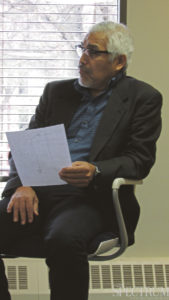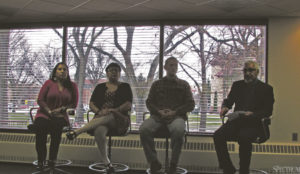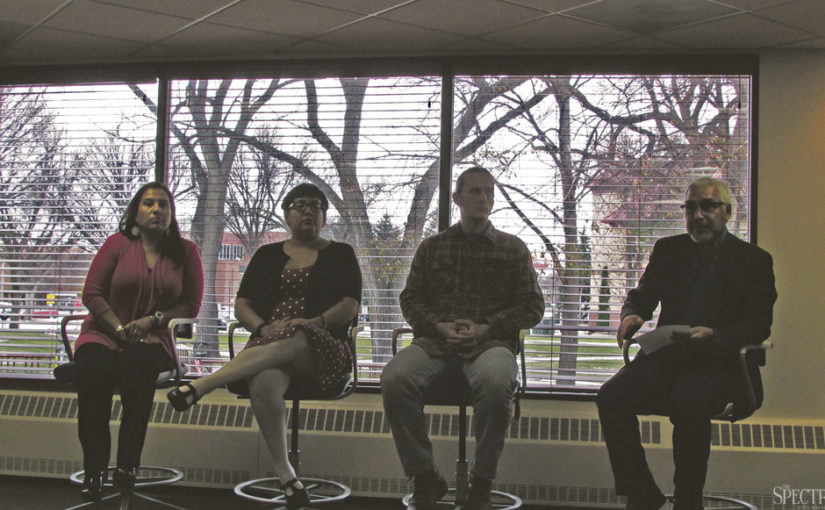Indigenous people and traditional foods can be overlooked, and the general public does not get information on how important and accessible they are. Focusing on the health and culture can help broaden the public’s view on the overall experience and foods never noticed before.
On November 7, the NDSU library held Traditional & Medicinal Food Panel, where three Native voices spoke about the importance in health that comes along with traditional foods. They spoke of their lifestyles as Indigenous People.

NDSU faculty member Michael Yellow Bird served as moderator for the three native voices.
Faculty member Michael Yellow Bird was the moderator of the panel. Yellow Bird is a part of Three Affiliated Tribes (Mandan, Hidatsa and Arikara). He has focused on multiple topics within his studies, including Indigenous people health, Indigenous peoples’ traditional mindfulness, rights of Mother Earth, etc.
Jacob Swaney-Walker, is a current Master’s in Public Health and PhD student at NDSU, and is a part of the tribe Piqua Shawnee and Potawatomi. Jamie Holding Eagle was raised in Fargo and is a part of Three Affiliated Tribes. Petra Reyna Harmon One Hawk, has a Master’s degree in Public Health and is a part of two tribes, Standing Rock Sioux Tribe and Lakota/Dakota Tribe.
Why become involved in traditional foods, professionally and academically?
Holding Eagle grew up with the typical family foods that are easy to buy and make, macaroni and cheese, Hamburger Helper, etc… “When I had kids, I suddenly had to change how I ate, so I was a fan of white bread and I had to eat the weird bread with the seeds in it, I had to cook vegetables, just stuff I had never really gotten into before,” Holding Eagle explained.
“Then as I got older I noticed that 90 percent of native people are lactose intolerant,” Holding Eagle shared, she had a mentality of “oh, we’re all supposed to eat that” when not everyone does.
A huge change she has seen is the fact her children do not know about foods that she grew up with, she gave the example of Spaghetti-O’s and how it is hard to describe what they are, and when you do so people think it sounds disgusting, when that is what we are taught to eat. “Having kids and changing my own bad habits” is why she decided to focus on the traditional foods.
“I took having access to traditional foods for granted, and never realizing the political issue that food is, I had a grandfather that lived with me – went out and harvested deer – I watched him harvest deer’s – all of that was just a normal part of the summer into the fall,” One Hawk explained.
That tradition stopped after the passing of her grandfather. Later in life, her brother was diagnosed with a disease where he cannot process fats quickly, so she tested for it. She was told if she does not start the way she eats, she would get diabetes and have a heart attack by her 40s, this caused her to transition back into her old traditions.
Throughout Swaney-Walker’s childhood he loved the outdoors and learning about different plants and what they do. “Those kinds of experiences all throughout my childhood – that was a learning process for me, then when I got into hunting at a young age – so that right there I learned a whole different process of gathering while gaining – that’s what shaped my desire to work outside,” Swaney-Walker said.

Panelist of native voices explain their experiences with indigenous foods.
(L to R) Petra Reyna Harmon One Hawk, Jamie Holding Eagle, Jacob Swaney-Walker, Michael Yellow Bird.
“Most of us don’t even know every day we eat indigenous food,” Yellow Bird transitioned, bringing up what the panelists prefer to eat as an ultimate favorite.
Swaney-Walker focused on his favorite Indigenous food, Wild Rice, and how common it is in the Midwest. “It is a very good source of Omega-3 which is very good for cardiovascular diseases,” Swaney-Walker said. Most get this fatty acid in fish and other sources, but this is a good plant source to find it. He explained how it was on the borderline of being good and beneficial as a grain.
Holding Eagle explained her favorite as Sweet Potatoes and how she does different things with it, for example she made sweet potato sushi. Another was Seater Tea, and how simple it is to get, for down the road someone has a bush that she cuts from. “Sometimes we get caught up in ‘oh I have to go to the store to buy this’” Holding Eagle said, when in reality it could be right next door.
One Hawk enjoys Timpsila, which is translated into prairie rice, this is needed to be done all at once, no breaks can be taken for, if you stop the plant will harden.
“I took that for granted, growing up in a family that harvested a lot of the traditional foods, where we have people coming to our family asking us to teach them,” One Hawk shared.
The importance of Indigenous foods is huge, for they help our health and keep us from thinking that everything should be processed and sold within a store setting.
“You don’t just have to be native to be interested in food, there’s a lot that we can share — right now in the face of climate change — we really need all kinds of observations and all kinds of techniques to do this in a manner that isn’t contributing to excess petroleum use,” Holding Eagle said.
“You’re seeing the effects of the huge health disparities that exist, heart disease, diabetes, and it’s all form not having access to healthy foods,” One Hawk explained.
Everyone’s concern with becoming healthier, by incorporating Indigenous foods is money, “will this be expensive?” is the common question asked.
To transform into this lifestyle is an expensive and time-consuming process, but worth your body feeling better. “You can integrate it every day,” Holding Eagle explained.
“It’s very expensive — the two worlds are really in collision with each other — taking two weeks off to go harvest Timpsila from work and we did have a chairman at one time who was really pro-culture, but if you don’t have those policies in place — taking two weeks off from work is really not reasonable,” One Hawk shared.
While money and time are a huge part Swaney-Walker shared the mental barriers when trying to harvest Wild Rice. When you go harvesting for Wild Rice you have warms crawling and biting all around you, along with this eventually the canoe starts to move from the bugs. This is all being done as you are getting little to no breaks.
While these seem like huge barriers for anyone who considered becoming healthier by focusing on these traditional foods, the focus of this lifestyle should be the experience and the fact that you “kind of do feel a little better when you eat this,” One Hawk said.
